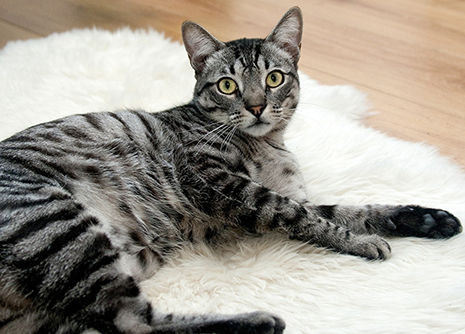
This is one of those tasks that sounds like it should be really easy – but actually it can be surprisingly hard! Until they begin puberty (usually at about 6 months old), male and female kittens are incredibly similar.
There are several different approaches that different people use to determine sex, and some are more reliable than others, so we’ll have a look at all the common ways to distinguish the boys from the girls.
Coat colour
This can sometimes give you a good indication – but it’s not always reliable!
Tortoiseshell cats are almost always female – the cat needs two X chromosomes to be a tortie (mixtures of three different colours) or a calico (patches of three different colours). However, some chromosomal abnormalities and a condition called chimaerism can result in male torties, so don’t rely on it!
Ginger tabbies are usually male – but again, not always.
All the other common colours can be male or female.
Facial features
When adult, tomcats tend to have a leaner, more muscular build, a broader face and a heavier skull.
However, these features are all driven by testosterone and are not present in kittens before puberty – just as you wouldn’t expect a young boy to have broad shoulders and a beard!
The facial features of male and female kittens are sufficiently similar that it isn’t possible to use them to tell the sexes apart.
Sex-linked behaviours
If the (older) kitten is calling and rolling, she’s in season (oestrus) and is therefore a female. Likewise, strong-smelling secretions from the base of the tail (“stud tail”) is unique to tomcats. However, most cats won’t enter puberty until about six months old, by which time its usually easier to use other methods!
Some books suggest that urine spraying is an indicator that the kitten is a male – however, although spraying is more common in adult tomcats, all cats will spray if they’re stressed, so this really isn’t terribly useful.
Genitalia
This is by far the most reliable method – actually look under the tail and see what’s there… However, it’s not as easy as it sounds – unlike most animals, boy cats have a fully retractile penis which points backwards underneath their bottom – while girls have their vulva in almost exactly the same place. As a result, a casual examination will reveal just two little holes, one above the other, in both sexes!
If possible, have a gentle feel and try to find his testicles – in a male kitten they’ll be in between the anus (top hole) and penis (bottom hole), and each one will usually be the size of a small pea. If you do find them, it’s definitely a boy! However, some kittens are a little shy (especially if they’re scared by being groped by a strange human), so if you don’t find any, it may just mean that he’s pulled them up inside out of harm’s way. As he gets older, they’ll spend more and more time outside, and by the time he’s six months old, they’ll probably be fully visible.
The anogenital distance is another really useful marker – but it’s easier if there are a couple of different kittens to compare. Females have a shorter distance between the two holes than males.
The final thing to check for is the shape of the genital orifice (the bottom hole). For girls, it’ll be a vertical slit, whereas the boys have a circular hole. So when you look at them from behind, a girl has a round anus and slit-like vulva like an i. The boys, meanwhile, have two round holes, like a :
Ideally, use a combination of all three genital components – testicles, distance and shape; or bring them in and our vets and nurses will be able to tell you!





